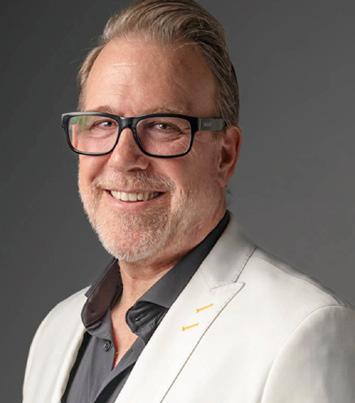
7 minute read
THE SILENT BURDEN
Vicarious trauma in investigative work
Dean Benard, president and CEO Benard + Associates
Vicarious trauma, also known as secondary traumatic stress, occurs when professionals are indirectly exposed to the trauma of others, leading to emotional and psychological distress. This phenomenon is prevalent among those who work closely with trauma survivors, including investigators, therapists, and first responders.
According to the American Counseling Association, vicarious trauma is “the emotional residue of exposure that counselors have from working with people as they are hearing their trauma stories and become witnesses to the pain, fear, and terror that trauma survivors have endured.”1
The emotional toll on investigators
Investigators often delve into distressing cases involving harassment, abuse, exploitation, and other forms of misconduct. This repeated exposure can lead to significant emotional exhaustion and stress. As noted in a study published in the Journal of Interprofessional Education & Practice, “Vicarious trauma, while it is different from post-traumatic stress disorder (PTSD), is associated with comparable symptoms, including re-experiencing, avoidance, and hyperarousal.2
Dr. Stephen Hydon, director at the University of Southern California’s School of Social Work , emphasizes that secondary traumatic stress is akin to PTSD but stems from indirect exposure: “Secondary traumatic stress is like PTSD, but it’s not your trauma. It’s the trauma of someone that you’re working with.”3
Recognizing the signs
The manifestations of vicarious trauma can be subtle and varied. Common signs include:
• Emotional exhaustion: feeling drained and overwhelmed.
• Increased anxiety: heightened stress levels and irritability.
• Depersonalization: emotional detachment from work and clients.
• Physical symptoms: headaches, fatigue, and gastrointestinal issues.
A resource from PositivePsychology.com outlines these effects, noting that “ongoing exposure to clients’ trauma stories can lead to emotional exhaustion.”4
The stigma of seeking help
Despite the prevalence of vicarious trauma, many professionals hesitate to seek support due to stigma and fear of professional repercussions. The case of Dr. Lorna Breen, an ER physician who died by suicide after battling exhaustion and anxiety during the COVID-19 pandemic, underscores the critical need for systemic change. Her family advocates that “doctors shouldn’t be ‘punished’ for seeking support.”5
Organizational responsibility
Organizations employing investigators must proactively address vicarious trauma by:
• Implementing regular debriefings.
• Offering training on vicarious trauma.
• Promoting a supportive culture.

A publication from the Government of British Columbia emphasizes the importance of creating a supportive work environment that encourages debriefing and provides opportunities for staff to discuss the impact of their work.6
Strategies for investigators
Investigators and their organizations can take several steps to mitigate the potential vicarious trauma or mental health impacts of their work. Bridge the Gapp Knowledge Centre offers a list of personal, professional, and organizational approaches to helping combat the impact.7
Organizational/professional:
• Creating awareness of vicarious trauma and the impacts on a person in the workplace helps to normalize the experience.
• Developing a supportive work environment that encourages debriefing of work-related issues.
• Taking regular breaks, mental health days and availing of peer support.
• Assessing and changing workload which may involve rebalancing caseload and workload reduction.
• Improving access to professional development and training.
• Providing opportunities for staff to safely discuss the impact of work on their personal and professional lives.
Personal:
• Improve self-care by taking time for hobbies and personal interests that feel good.
• Maintain social support at home and at work.
• Increase self-awareness by tuning in to stress signals.
• Reflect on current feelings and reactions, as well as the influence of past experiences.
• Monitor your work–life balance.
• Check in on your job satisfaction.
• Limit exposure to trauma-related material, such as news stories or movies.
• Access regular coaching, counselling and supervision to help counterbalance any existing vulnerability, such as a personal trauma history.

Practical strategies for managing emotional impact during investigative interviews
During an interview, investigators can experience a sense of feeling trapped and unable to manage the feelings created as they listen and gather information. They are working to minimize trauma in the interviewee, and this can create stress and impact their own performance as they manage the push and pull of the interaction, caring for the interviewee, and often putting themselves last. Here are some things to consider as you work to manage the emotional impact:
1. Ground yourself before and after each interview
Take a few minutes before the interview to center yourself. Simple breathing exercises, brief mindfulness moments, or setting a clear intention for the interview can make a meaningful difference. After the interview, allow time to decompress, don’t rush into the next task.
Tip: Try the box breathing method to reduce stress ‘4-4-4’ breathing method: inhale for 4 seconds, hold for 4, exhale for 4.
2. Use objective framing to maintain boundaries
Emotionally difficult content can become overwhelming when we start personalizing it. Maintain a clear mental separation between the speaker's experience and your role in documenting it. Mental mantra: “I am here to listen and document—not to absorb or fix.”
3. Acknowledge, but don’t absorb
Empathy is essential, but over-identifying with the individual can lead to emotional exhaustion. Use compassionate responses like “I appreciate you sharing that” without internalizing the distress.
4. Take notes strategically
If the content is disturbing, taking notes can create a degree of emotional distance. It anchors you in the task of evidence collection rather than emotional reaction. Note: Be mindful of tone and body language to remain present and supportive while documenting.
5. Have a personal signal or reset mechanism
Some investigators use small, unobtrusive physical reminders, a smooth stone in their pocket, a bracelet, or even a breath pattern, to stay grounded during intense moments. These act as reset tools when emotional overwhelm begins to rise.
6. Remember you too can take a break
We often tell those we interview that if they need a break they just need to ask. There could be times you need that break too, try to plan as the interview unfolds for a moment you can call for a short break, without disrupting the flow of the interview. This is a judgement call, but sometimes the one to make.
7. Debrief with a trusted peer or supervisor
After a particularly difficult interview, don’t keep it bottled up. A quick debrief, even a five-minute vent or check-in, can provide emotional release and validation.
8. Monitor your internal dialogue
Be aware of self-talk that could signal emotional strain (“This is too much,” “I can't do this anymore”). These thoughts are not failure; they're cues that you need a break or support.
9. Normalize the impact
Understand that having an emotional response doesn’t make you less professional. It makes you human. Make space for reflection and know when to say, “I need to take care of myself so I can continue doing this work well.”
10. Build a ritual of closure
Develop a small ritual at the end of your day to signal to your body and mind that work is over. This might include closing your laptop, stepping outside, journaling, or changing into non-work clothes. Over time, this tells your nervous system it's safe to rest.
Vicarious trauma is an inherent risk in investigative work, but it doesn't have to be an inevitable consequence. By acknowledging its presence, fostering supportive organizational cultures, and implementing proactive strategies, we can safeguard the mental health of those dedicated to seeking truth and justice.
1 American Counseling Association. Vicarious Trauma. Available at: https://positivepsychology.com/vicarious-trauma
2 Knight, C. (2021). Vicarious trauma in health and social care: Exploring the link with PTSD symptoms. Journal of Interprofessional Education & Practice, Volume 25. Available at: https://www.sciencedirect.com/science/article/pii/S2405452621000380
3 Stephen Hydon, quoted in: Will, M. (2018). After the Fires, L.A. Teachers Are Experiencing Secondary Trauma, According to One Expert. The 74 Million. Available at: https://www.the74million.org/article/ after-the-fires-la-teachers-are-experiencing-secondary-trauma-according-to-one-expert
4 Ackerman, C. E. (2023). Vicarious Trauma: What It Is and How to Cope. PositivePsychology. com. Available at: https://positivepsychology.com/vicarious-trauma
5 Feist, C. (2021). Dr. Lorna Breen Died by Suicide. Her Family Wants to Protect Other Health Care Workers From the Same Fate. TIME Magazine. Available at: https://time.com/6100300/corey-feist-lorna-breen
6 Government of British Columbia. Vicarious Trauma and Organizational Supports – Resource List. Available at: https://www2.gov.bc.ca/assets/gov/health/managing-your-health/mental-health-substanceuse/child-teen-mental-health/vicarious_trauma_and_organization_resource_list.pdf
7 Compassion Fatigue & Vicarious Trauma – Knowledge Centre. Bridge the Gapp. Available at: https:// bridgethegapp.ca/adult-national/knowledge-centre/compassion-fatigue-vicarious-trauma

